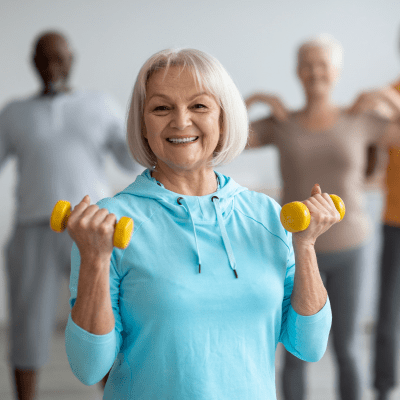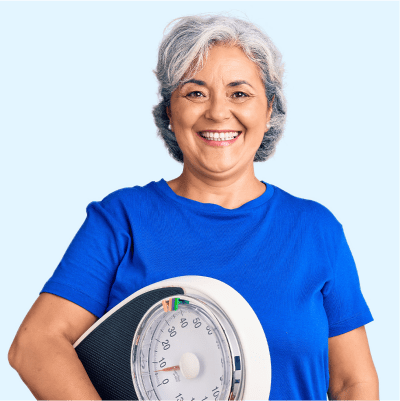GLP-1 Meal Plan: A Guide to Good Nutrition While Taking GLP-1 Medications
Glucagon-like peptide-1 (GLP-1) medications are widely recognized for their ability to help manage diabetes and support and weight management. Pairing these medications with a balanced diet is essential to maximizing their benefits.
In this guide, we’ll explore nutrition strategies to optimize your results and address common side effects of GLP-1 medications.
Why Nutrition Matters With GLP-1 Medications
GLP-1 medications reduce appetite, slow gastric emptying, and improve blood sugar control. While these effects can promote weight loss, they may also result in early feelings of fullness, nausea, diarrhea, or constipation. Ultimately, this makes it difficult to meet nutrition goals for protein, fiber, vitamins, and minerals. A well-structured meal plan helps you overcome these challenges, ensuring you meet your health goals.
Key Principles of a GLP-1-Friendly Meal Plan
To get the most out of GLP-1 medications, it’s important to follow a diet that complements their effects while supporting your overall health. The right meal plan can help you maintain energy, stay on track with your weight and health goals, and minimize potential side effects. Here are six key principles to guide your nutrition choices:
- Small, frequent meals. Eat evenly spaced meals every three to four hours to avoid missing meals. Waiting until you feel hungry can lead to undereating, affecting your progress. Worse, skipping meals can lead to poor nutrition and vitamin deficiencies.
- Plan your protein. Protein helps support lean muscle mass and keeps you feeling full longer. Great lean protein sources include chicken, fish, eggs, tofu, and low-fat dairy. However, eating protein at every meal may not be enough if you feel full quickly and can’t finish your food. Aim for 30 grams of protein per meal and at least 10 grams per snack. You can reach these goals with food alone or by combining food with Unjury® Protein Powders to help you meet your daily protein needs. For those with a lower appetite who still need balanced nutrition, protein meal replacements are another helpful option.
- Prioritize fiber. While protein is important, don’t overlook fiber. Many patients prioritize protein exclusively, which can worsen constipation—a common side effect of GLP-1 medications. Fiber from whole grains, fruits, vegetables, and legumes helps maintain regularity and supports gut health.
- Choose low-glycemic carbohydrates. Incorporate slow-digesting carbs like oats, quinoa, beans, peas, and sweet potatoes to provide consistent energy and stabilize blood sugar levels. Bonus: Many of these foods are also great sources of fiber.
- Healthy fats in moderation. Add fats like olive oil, nuts, and seeds to meals for satiety and heart health.
- Stay hydrated. Adequate hydration supports digestion, reduces constipation, and helps your body process nutrients effectively.
Sample GLP-1 Diet Plan
Here’s an example of a balanced, GLP-1-friendly meal plan to help you stay on track with your nutritional goals. This plan emphasizes protein, fiber, and hydration while offering variety and flexibility to suit your needs.
Breakfast—7 AM
- 1 boiled egg (6g protein)
- ¼ avocado on whole-grain toast (4g protein, 5g fiber)
- 8 oz. water
- Iced Mocha Unjury Protein Coffee (17g protein, 4g fiber)
- Total: 27g protein, 9g fiber
Midmorning snack—10 AM
- ½ cup vanilla, fat-free Greek yogurt (9g protein)
- ½ cup of raspberries (4g fiber)
- Total: 9g of protein, 4g of fiber
Lunch—1:30 PM
- 4 oz. grilled chicken breast (28g protein)
- ½ cup cooked quinoa salad with spinach, 4-5 small cherry tomatoes, and a lemon vinaigrette (5g protein, 2g fiber)
- ½ cup steamed zucchini (1g protein, 1g fiber)
- Total: 34g of protein, 3g of fiber
Afternoon snack—4:30 PM
- Unjury Protein Water (20g protein)
- ¼ cup of mixed nuts (5g protein, 3g fiber)
- Total: 25g of protein, 3g of fiber
Dinner—7 PM
- 4 oz. baked salmon (25g protein)
- ½ cup roasted Brussels sprouts (2g protein, 2g fiber)
- ½ cup mashed cauliflower (1g protein, 2g fiber)
- ½ cup of cooked wild rice (4g protein, 2g fiber)
- Total: 32g of protein, 6g of fiber
Daily total
- 127g of protein, 25g of fiber
Tips for Success
- Don’t wait to feel hungry: Stick to a schedule and eat every 3-4 hours to ensure you meet your nutritional needs.
- Plan for protein: Strategize your meals and snacks to hit protein targets of 30 grams per meal and 10 grams per snack. Use protein-rich foods and supplements like Unjury to help meet your protein goals.
- Fiber is your friend: Combine fiber-rich foods with adequate hydration to manage constipation effectively.
- Adapt when needed: If nausea or fullness occurs, adjust portions and opt for bland, easily digestible foods until symptoms subside.
Additional Considerations
In addition to following a GLP-1-friendly meal plan, there are other factors to keep in mind to ensure success. Certain habits and food choices can affect how well you tolerate the medication and achieve your goals. Here are some additional considerations to guide your journey.
Avoid Alcohol
While an occasional drink may be fine for some, alcohol can pose challenges when taking GLP-1 medications. It is high in calories, which can slow weight loss progress, and it may worsen side effects like nausea or diarrhea. Alcohol can also lead to disinhibited eating and dehydration, further complicating your nutrition and hydration goals.
Foods to Avoid
Certain foods can exacerbate GLP-1 side effects. High-fat and high-sugar foods, for example, may trigger nausea or other digestive issues. These foods are often low in protein and essential nutrients, making them less helpful for achieving your nutrition targets. Focus on whole, nutrient-dense options instead.
Conclusion
Combining GLP-1 medications with a balanced, strategic meal plan can help you maximize results while minimizing side effects. Prioritizing protein and fiber, eating consistently, and staying hydrated while avoiding potential challenges like alcohol and nutrient-poor foods are all key to success.
Supplements like Unjury can fill in gaps when needed, ensuring you stay on track. Talk with your healthcare provider or registered dietitian to personalize your plan and achieve your goals.













